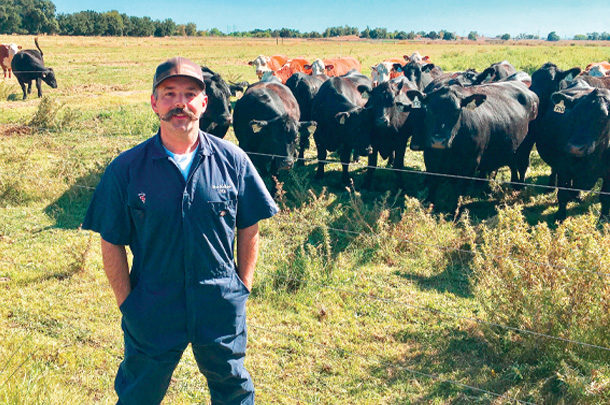Reproductive diseases can damage a cattle operation’s profitability for months and even successive years. According to a 2009 USDA study, embryonic mortality, pregnancy loss and reproductive inefficiency in domestic beef and dairy cattle cost global producers over $1 billion annually.
Trichomoniasis
“Trichomoniasis remains as a large reproductive disease concern. It’s caused by a single-celled protozoan organism living on the surface of a bull’s penis and sheath,” says Bret McNabb, professor of livestock reproduction and director of the large animal clinic at the University of California, Davis. “During breeding, it’s very efficiently transmitted to the female where she will manifest its effects.”

Trich has long been a concern among bulls, but it has an impact spread among cows as well. Photo provided by Bret McNabb.
McNabb explains infected animals will normally still conceive. The organism enters the uterus along with the sperm, triggering an inflammatory reaction. Large amounts of white blood cells cause a pus-filled uterus, an environment where the embryo dies within weeks.
“We see conception followed by embryonic loss. Often, the female will develop a pyometra uterus, but eventually will clear the infection and breed back, conceive and carry a calf to term. The short immune response she receives is beneficial to deliver a late calf.”
Clearing and implications
Most cows clear the infection in four to six weeks and retain some immunity for the rest of the season. Those not clearing will be open or host pyometras when palpated during pregnancy checking.
“There are many different implications of this. It’s not a disease with human health consequences, but an economic disease,” McNabb stresses. “If it gets in a herd, it can be devastating. Producers can lose a calf crop or realize a very reduced one. In a long breeding window, many will conceive near the end, so calves will be lighter at weaning.”
Aggravating the issue, while infected, females harbor the organism in their vagina and can pass it to numerous clean bulls in multi-sire breeding pastures.
McNabb recommends continual testing of bulls with culling of any confirmed positive results. Pyometras samples could also be sampled and tested. Vaccines are available, and he believes they have a place but warns they don’t prevent infections, but they tend to slightly increase pregnancy rates when trichomoniasis (trich) is present.
Don’t forget the cows
Grant Dewell, Iowa State Beef Extension veterinarian, says although bulls are the main culprits spreading trichomoniasis, over the past 10 years cows have begun to move around more and should also be a focus of prevention.
“Trich moves around the country,” he notes. “When someone sells an open cow at the sale barn, someone else brings her in, not knowing she’s open because of trich. She then introduces it to bulls and other females. We do a pretty good job handling bulls with trich but tend to forget cows can carry it.”

Herds hit with trich can often be infected for one year, with leftover immunity carried for following years. Photos provided by Bret McNabb.
He explains historically it was seen in the western U.S. as a common reproductive problem of open-range systems. Significant time and energy were spent in the 1980s and ‘90s getting rid of it. In the early 2000s, producers started moving cows around more as droughts and markets became more impactful. Now, he believes trich is back under control and hopes the lesson has been learned regarding the importing of cattle.
States set their own testing and regulatory rules, although there’s little agreement between them on how to address the disease. Many enforce an 18-month-or-older test before sale or allowing entry.
Often, regulatory testing dictates the type of test, typically a scraping or polymerase chain reaction (PCR) test of the prepuce and penis. Positive bulls must be slaughtered and cannot be sold for breeding.
Dewell says herds recover over time with naïve females initially becoming infected, losing their fetuses, then cycling back and becoming bred. Usually, they acquire enough local immunity to carry a late second fetus.
In a 20-cow herd, most would be infected in the first year of infection. Subsequent years would show some carrying leftover immunity.
“Maybe 50 percent will have leftover immunity in the next year. They can recover in time. We won’t have 95 percent pregnancy rates, but we’ll be back in the 80 percent range. Most might be protected, but we’ll still have susceptible animals if we don’t do something to get rid of the organism.”
Other reproductive diseases
Vibriosis is similar to trichomoniasis and is a venereal disease caused by a bacterium living in the lining of a bull’s reproductive tract. It’s also transmitted during breeding, says McNabb, but unfortunately, it’s not usually discovered until preg checking. Results are embryonic losses and late abortions. Vaccines are available for control, and both bulls and cows should be vaccinated before breeding seasons.
Infectious causes including bovine viral diarrhea (BVD) and bovine herpesvirus (IBR) are spread through direct contact or bodily fluids. Both can cause abortions and fetal issues but can also be counteracted with vaccines.

If pasture is irrigated or in moist environments, it can be a breeding ground for leptospirosis. Photo provided by Bret McNabb.
“Irrigated pasture, grass along lakes and moist environments are great breeding ground for leptospirosis,” McNabb said. “This infection is shed into water from wildlife, hogs, deer or rodents. A cow drinks and becomes infected. The cattle-adapted strain causes abortions and sets up a persistent or chronic infection in renal systems, kidneys and urinary tracts but can be nullified with vaccines.”
McNabb says anaplasmosis also triggers abortions, although normal results are an acute onset leading to sudden death. In many of the western states, anaplasmosis is endemic and calves born and raised in those areas are carriers but aren’t typically affected. Females naïve to anaplasma entering endemic areas are typically where problems arise.
Neospora is a reproductive disease caused by spores in dog feces entering feed sources. Cattle ingest the contaminated feed and can abort or have a persistently infected calf. No vaccines are available for neospora, so control is through biosecurity methods.
“For all reproductive diseases, knowing what’s in an area and what risks you have is extremely important,” McNabb explained. “General multivalent vaccines are pretty good value to cover those viral components, leptospirosis and vibriosis. It’s critical to try and determine the cause of abortions. Send samples of a placenta or blood to a diagnostic lab to rule out infections. Use herd biosecurity and minimize contact with outside cattle whenever possible.”











